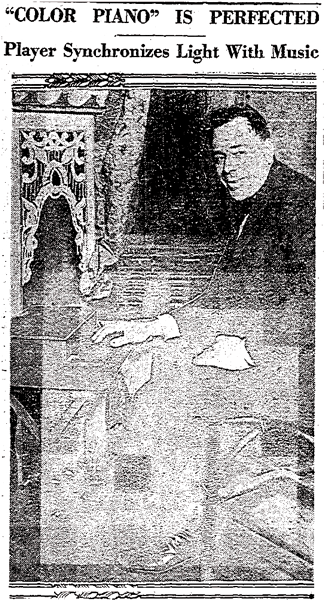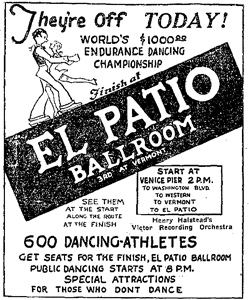January 26, 1927
Los Angeles
Scientists and composers, having long toiled in vain to produce color symphonies, have been bested by, of course, an ingenious Angeleno.
 Leo Geasland, an electrician at the El Patio Ballroom, has finally perfected the synchronization of color and music.
Leo Geasland, an electrician at the El Patio Ballroom, has finally perfected the synchronization of color and music.
Geasland’s invention consists of a ten-key keyboard on his right, and a switchboard on his left. These he operate in rhythm to the orchtestra, throwing changing rhythmic combinations to 6,000 incandescent bulbs. With an unlimited combination of 280 major colors, he controls 1,800 rose, 1,500 red, 1,000 amber and 2,000 blue lights. (Green was omitted from Geasland’s color scheme because of its effect on the complexion; this we applaud.) The contraption’s 1,400 wires and 100 circuits is about adequate to light a city of 30,000. Writes the Times, “As the fingers of Geasland move over the keys, the colors flash and dance on the walls, ceiling and pillars of the ballroom in perfect synchronization to the music, producing an effect of beauty and harmony that is unusual.”
Because there were no contemporary accounts of what it was like to witness the spectacle of the “color piano,” I’m just going to go ahead and make one up:
 In a 1933 article about Geasland’s apparatus, it’s noted that the blind and deaf are admitted for free every Monday evening to the Rainbow Gardens (the El Patio became the Rainbow in 1930, and thereafter the Palomar Ballroom). The deaf would dance to the base and time beats of the music in rhythm to the lights, as other lights would carry on the harmony. The blind could just dance to the music, but Geasland declared that they, too, were noticeably affected by the lights they could not see. “They seem to feel them,” said Geasland. “Often a blind couple will get right under a circle of the base lights and keep dancing around and around right there. I have watched them many times, and feel sure they feel they rhythm of the lights they cannot see.”
In a 1933 article about Geasland’s apparatus, it’s noted that the blind and deaf are admitted for free every Monday evening to the Rainbow Gardens (the El Patio became the Rainbow in 1930, and thereafter the Palomar Ballroom). The deaf would dance to the base and time beats of the music in rhythm to the lights, as other lights would carry on the harmony. The blind could just dance to the music, but Geasland declared that they, too, were noticeably affected by the lights they could not see. “They seem to feel them,” said Geasland. “Often a blind couple will get right under a circle of the base lights and keep dancing around and around right there. I have watched them many times, and feel sure they feel they rhythm of the lights they cannot see.”
Geasland goes on to say that in time, big orchestras everywhere will have light players as well as instrument players. “They make rhythm visible…so they help people feel and appreciate the music.”
Sadly, on October 2, 1939, the bass viol player dropped his resin rag on a 150-watt floodlight during Lionel Kaye’s “daffy auction,” and the Patio/Rainbow/Palomar burned to the ground, Gaesland’s invention therein.
